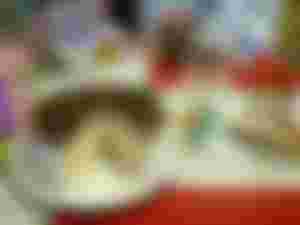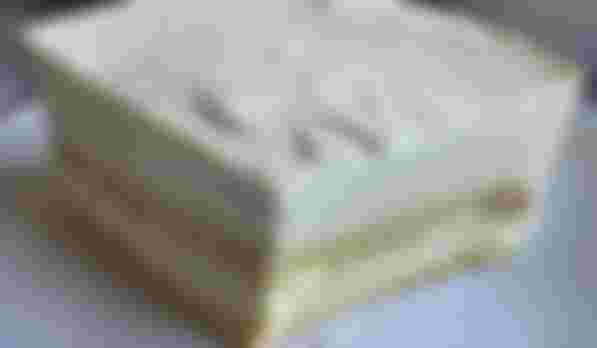"Bird's Milk"
Good morning, dear readers of read.cash! Today is July 17 and July is a beautiful day. Yesterday I baked a delicious "Bird's Milk" cake that I want to tell you about today, maybe some of you would like to make it too and get the recipe.The most complicated cake I have ever eaten.That I have ever had to make. Period of my own creation.I became mathematician, chemist, physicist, not.I don't know what else)))) the result is stunning!A good recipe for double poultry milk.Everyone liked it very much!Pie!
Ingredients
This cake is a classic cake. Light and harmonious in flavor, easy and quick to make. Thanks to my detailed masterclass with all the steps, even a beginner will be able to make this wonderful cake. The main thing is to buy good quality agar. However, this is not a problem today.
Oh, bird's eye, I've probably made this cake a thousand times! Different variations, different recipes, which nevertheless still look like sisters, usually just different in proportions. I've tried with more and less sugar, with more and less agar, with cream, with butter, with condensed milk.... I've even tried it with gelatin). I've added layers of berries and currants! With milk and dark chocolate, with cream frosting, with butter frosting.... And not because I like this cake so much. Yes, my family loves it, but I'm not a big fan myself. But my interest in sports, my obsession with baking and my desire to find a recipe that I say, "Great!" have done the trick). Anyway, now I am definitely a master of bird's milk cake).
Many people say it's too sweet and try to cut down on sugar. Some people say it's too oily, so they choose cream instead of buttercream for the soufflé. I have probably tried all these combinations and I can tell you this: no matter how much sugar you reduce in an agar soufflé, it will still be sweet, in fact, I think it will be almost as sweet. Because the syrup has to be made at a certain temperature (110 degrees) and therefore has to have a certain consistency, using less sugar simply means less syrup, no more, and that (with the same protein content) already has an effect on the texture of the soufflé, which in my opinion is even greater than the infamous sweetness of bird's milk. That's why I didn't like the cream version at all: the soufflé barely held its shape. Yes, it melted in the mouth, but that's not all! In my opinion, a real "bird" soufflé should be slightly elastic, light and airy, but not completely weightless; it should have a rather noticeable density. The sponge cake pieces do not fall apart when cut, but retain their shape well when transferred to the plate. They resemble the candy of the same name. I would also reject the poultry milk cake with jelly: also delicious and even very tasty, just not the same.
Of course, it all depends on taste. You may disagree with me. Nevertheless, I highly recommend "my" version of butter cake, which of course I did not invent, but which I found, tasted and chose from many others. I have filmed the whole process of making this cake step by step in a video, so you can understand it as best you can, even if you have never made a cake before! It's hard to go wrong, as it's one of the easiest and fastest cakes in the world).

Let's get started!
I'm making cookie dough!
By the way, I've also tried different cookies with this cake. Gostoff's version is a shortbread dough, many bakers make homemade bird's milk with a classic cookie and let it soak well, I came across a version with almond biscuit....
And we will bake something between the dough and the sponge. Specifically, we will make the dough from egg yolks (we still need a soufflé white, so we will also use egg yolks). When baked and cooled in thin layers, it is medium-thick and crumbly, but it does not crumble like "sand" and goes well with a soft soufflé.
For two cakes with a diameter of 16 cm, you will need 80 g of butter at room temperature and 80 g of icing sugar or powdered sugar. Put them in a bowl.
Mix well in the mixer on high speed until the mixture becomes light and fluffy. You can add vanilla extract (1 tsp) or vanilla sugar (10 g).
Add the 3 egg yolks one at a time, beating well after each yolk.
Sift 100 g flour, 0.3 teaspoons baking powder and a pinch of salt into a separate bowl. Mix well with a whisk.
Add the dry ingredients to the butter-egg mixture.
Mix with an electric mixer at low speed until smooth.
Fry the crust!
Now take a 16cm diameter tin (I have a pasta pan), line the bottom with baking paper or place on a baking tray/silicone mat. Spread half of the dough (it's best to measure it so the crust is even!) as evenly as possible. It's easiest to use a small curved ink knife, like the ones artists use for oil painting. If you're struggling, you can use a silicone spatula to help you.
Put them in a preheated oven at 180 degrees for about 15 minutes - until lightly browned. The exact time depends on the oven!
Do the same with the other crust. If your oven can bake two pies at the same time, you're in luck, so use it).
Freshly baked pies are very fragile, so handle them with care. They'll firm up a bit as they cool, but they're still pretty brittle, so be careful.
While the pies are cooling...
... we're making soufflés!
For this we need a very important ingredient - agar-agar. This is a natural thickening agent of vegetable origin. It comes from seaweed. It is considered to be analogous to gelatin, but only the work with agar is very different, and products made with agar have a completely different texture than gelatin. Agar-agar has different strengths, but I have never seen the strength level indicated in any way, nor have I ever seen the gelatin packaging indicate how long it blooms (a measure of gelatin strength). Unfortunately, you have to learn all this yourself.
It's also good to remember that agar fades with long-term storage. Fresh agar is stronger. So if you buy a lot at once, plan in advance where you will use them and don't leave them unused; it's very handy that they are sold in small 10 gram packets. For example, one packet is enough for three standard cakes, like Bird`s milk!Put it in a medium (not small!) saucepan. Pour in 270 g of cold water. Stir and set aside.
Now take 180g of butter at a good room temperature and 80g of good quality condensed milk.
Beat at high speed until you have a light, fluffy cream. If you are using vanilla extract, add it now (1 teaspoon). Set aside.
Remove any remaining egg whites from the yolks once the cakes are baked. I remind or tell those who don't know that the whites must be separated very carefully in a dry bowl so that not a drop of yolk gets into the whites. Put the egg whites in a large bowl and add a pinch of citric acid.
Prepare the baking tin
You can easily make this cake directly in the tin. Put an 18 cm diameter cake tin (or a bottomless cake tin) in the bottom and line the sides with acetate or other thick, smooth baking paper, not foil: if it's too thin and soft, it will curl and the sides of the cake won't be straight.
Back to the bait.
Bring the agar and water to a boil. Pour in 430 grams of sugar (don't worry, I thought it was too much, but the soufflé wasn't cheesy, it was very balanced, as it should be!)Bring the food to the boil. The syrup bubbles up and starts to fizz! This is why you shouldn't use a small container.
Continue to boil the syrup. When it starts to bubble actively, it will settle down a bit, but will continue to bubble. Boil for about 10-12 minutes, up to 110 degrees (if you have a thermometer), or until the syrup is what is called "thin" when a spatula or spoon holds the syrup like a thread.
But! Until the syrup reaches the right consistency and temperature (about 105 degrees or 8 minutes, but this depends very much on the pan and type of fire), the egg whites should be stiffly beaten frothy.Here, the syrup is ready! This was hard to do, but I hope it's clear: the syrup is actually on the unbroken string behind the whipped cream. You'll see!Turn the mixer back on and, beating the egg whites at high speed, pour the syrup in a thin stream. Try not to pour it over the whipped cream!
The dough will get lighter and bulkier before your eyes!Mix with a mixer for another minute or two. The dough will continue to rise and firm up.When you see that the puff has risen in the whipped topping, you can stop at this point.
Add the buttercream you prepared earlier.And, using the mixer, fold into the white mixture on low speed.The mixture liquefies immediately, but not too much. Blend until you have a smooth mixture. The soufflé is ready! And now...
...assembling the buttermilk biscuits!The soufflé will be ready quickly, so the waltz will be appropriate. But if you've prepared everything beforehand, don't worry, don't worry, do everything right, everything will be fine.
Remove the pre-prepared mould with the lining. Lay the first sheet on the bottom.
Pour half of the soufflé on top. If possible, measure the cake with a scale and assemble it so the layers are even. I haven't done this, but it's better if I have everything handy and can measure the plate I'm making the soufflé on beforehand. Once you've measured the soufflé with the bowl, simply subtract the weight and divide the resulting number in half.Insert the second cake. It pushed easily into the soufflé, I didn't have to help it.
Pour the second part of the souffle over it. That's it! Put the cake in the fridge or freezer and keep it there until the souffle is done. This happens very quickly, but it's best to keep it longer, at least an hour or two. When the time is up.
The icing is done
Oh, this is a must! Dark chocolate definitely sweetens the sweetness of the soufflé and makes the overall taste of the cake more harmonious. Take 65g of good dark chocolate (mine has 54% cocoa, but you can go higher).And 40g of good butter.Defrost everything in the microwave or water bath. Be careful: don't overheat! Heat in the microwave for 15-20 seconds, then remove, stir and heat again for the same time. And so on until the chocolate and butter melt. Otherwise, there's no need to try to melt everything: it will simply "boil" in the bowl due to its heat.
Stir everything together until smooth. The glaze should be nice and shiny and fragrant. Let it cool a little, it doesn't have to be hot, just a little warm, but it should keep its liquidness!
Remove the cake.
Now you can remove the tinfoil, but not the acetate foil! Pour the icing over the cake. Lift the cake, holding it by the lining, and turn the weight so that the icing is evenly distributed over the surface. Put the cake in the fridge or freezer to set the icing. This will take at least an hour. I don't have the smoothest frosting, but that's okay (I've practiced 1001 times), because if you make samples, you still won't see any bumps.I make samples with plain, unpainted chocolate. Break about 30g of chocolate into pieces or buy muddled chocolate and put it in a piping bag.
And soak it in hot water for a few minutes.Then wipe the bag with a paper towel (chocolate is very afraid of moisture!), cut off a small end and paint) There's a "but": if something goes wrong, you can't paint it again, and if you remove it, you'll damage the surface of the glaze. Think about what you want to represent. I couldn't think of one and made it up as I went along) But it was still good. I actually fell in love with this cake while baking, photographing and tasting it). It's so soft!
By the way, the buttermilk cake tasted even better the next day - yay! So you can make it in the evening. And it tolerates room temperature perfectly: the soufflé doesn't puff up in the agaric heat, unlike the gelatin foam, and the cake doesn't warp. By "warm," of course, I don't mean 30 degrees in direct sunlight (you get that, right?).
Try this cake! Unlike all other cakes that need to be baked and stored in advance, cakes and cream need time to "harden" once assembled, long before they are set, shaped or whipped..... This cake doesn't need it, but it's elegant, festive and very delicious. Material and labor costs are quite reasonable compared to other cakes.

Have fun in the kitchen and delicious results!🥞👋


Definitely gonna try it out..ヾ( ͝° ͜ʖ͡°)ノ♪